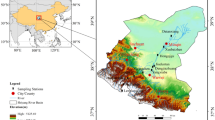Abstract
The humidity effect, namely the markedly positive correlation between the stable isotopic ratio in precipitation and the dew-point deficit ΔT d in the atmosphere, is put forward firstly and the relationships between the δ18O in precipitation and ΔT d are analyzed for the Ürümqi and Kunming stations, which have completely different climatic characteristics. Although the seasonal variations in δ18O and ΔT d exhibit differences between the two stations, their humidity effect is notable. The correlation coefficient and its confidence level of the humidity effect are higher than those of the amount effect at Kunming, showing the marked influence of the humidity conditions in the atmosphere on stable isotopes in precipitation. Using a kinetic model for stable isotopic fractionation, and according to the seasonal distribution of mean monthly temperature at 500 hPa at Kunming, the variations of the δ18O in condensate in cloud are simulated. A very good agreement between the seasonal variations of the simulated mean δ18O and the mean monthly temperature at 500 hPa is obtained, showing that the oxygen stable isotope in condensate of cloud experiences a temperature effect. Such a result is markedly different from the amount effect at the ground. Based on the simulations of seasonal variations of δ18O in falling raindrops, it can be found that, in the dry season from November to April, the increasing trend with falling distance of δ18O in falling raindrops corresponds remarkably to the great ΔT d, showing a strong evaporation enrichment function in falling raindrops; however, in the wet season from May to October, the δ18O in falling raindrops displays an unapparent increase corresponding to the small ΔT d, except in May. By comparing the simulated mean δ18O at the ground with the actual monthly δ18O in precipitation, we see distinctly that the two monthly δ18O variations agree very well. On average, the δ18O values are relatively lower because of the highly moist air, heavy rainfall, small ΔT d and weak evaporation enrichment function of stable isotopes in the falling raindrops, under the influence of vapor from the oceans; but they are relatively higher because of the dry air, light rainfall, great ΔT d and strong evaporation enrichment function in falling raindrops, under the control of the continental air mass. Therefore, the δ18O in precipitation at Kunming can be used to indicate the humidity situation in the atmosphere to a certain degree, and thus indicate the intensity of the precipitation and the strength of the monsoon indirectly. The humidity effect changes not only the magnitude of the stable isotopic ratio in precipitation but also its seasonal distribution due to its influence on the strength of the evaporation enrichment of stable isotopes in falling raindrops and the direction of the net mass transfer of stable isotopes between the atmosphere and the raindrops. Consequently, it is inferred that the humidity effect is probably one of the foremost causes generating the amount effect.
Similar content being viewed by others
References
Araguas, L., K. Froehlich, and K. Rozanski, 1998: Stable isotope composition of precipitation over south-east Asia.J. Geophys. Res.,103, 28721–28742.
Dansgaard, W., 1964: Stable isotopes in precipitation.Tellus,16(4), 436–468.
IAEA/WMO, 2001: The GNIP Data Release 3. [Available online at http: //www. iaea. org. programs/ ri/ gnip/ gnipmain. htm.]
Jouzel, J., 1986: Isotopes in cloud: Multiphase and multistage condensation process.Handbook of Environmental Isotope Geochemistry, Vol. 2, P. Fritz and J. Ch. Fontes, Eds., Elsevier Scientific Publishing Company, 61–112.
Jouzel, J., K. Froehlich, and U. Schotterer, 1997: Deuterium and oxygen-18 in present-day precipitation: Data and modeling.Journal of Hydrological Sciences,42(5), 747–763.
Rozanski, K., and C. Sonntag, 1982: Vertical distribution of deuterium in atmospheric water vapor.Tellus,34(1), 135–141.
Rozanski, K., S. J. Johnson, and U. Schotterer, 1997: Reconstruction of past climates from stable isotope records of palaeo-precipitation preserved in continental archives.Journal of Hydrological Sciences,42(5), 725–745.
Stewart, M. K., 1975: Stable isotope fractionation due to evaporation and isotopic exchange of falling water drops: Application to atmospheric processes and evaporation of lakes.J. Geophys. Res.,80, 1133–1146.
Tian, L., T. Yao, P. F. Schuster, J. W. C. White, K. Ichiyanagi, E. Pendall, and J. Pu, 2003: Oxygen-18 concentrations in recent precipitation and ice cores on the Tibetan Plateau.J. Geophys. Res.,108, 4293–4298.
Yao Tandong, 1999: Abrupt climatic changes on the Tibetan Plateau during the Last Ice Age.Science in China (D),42(3), 358–368.
Yapp, C. J., 1982: A model for the relationship between precipitation D/H ratios and precipitation intensity.J. Geophys. Res.,87, 9614–9620.
Zhang Xinping, and Yao Tandong, 1998: Distributional features of δ18O in precipitation in China.Journal of Chinese Geography,8(2), 157–164.
Zhang Xinping, Xie Zichu, and Yao Tandong, 1998: Mathematical modeling of variations on stable isotopic ratios in falling raindrops.Acta Meteorologica Sinica,12(2), 213–220.
Zhang Xinping, M. Nakawo, K. Fujita, Yao Tandong, and Han Jiankang, 2001: The variation of precipitation δ18O in Langtang Valley, Himalayas.Science in China(D),44(9), 769–778.
Zhang Xinping, Yao Tandong, and M. Nakawo, 2002: Meridional variation of stable isotopic compositions in precipitation of the Tibetan Plateau and its adjacent regions.Journal of Glaciology and Geocryology,24(3), 245–253. (in Chinese)
Zhang Xinping, Yao Tandong, Liu Jingmiao, Tian Lide, and M. Nakawo, 2003: Simulations of stable isotopic fractionation in mixed cloud in middle latitudes—Taking the precipitation at Ürümqi as an example.Adv. Atmos. Sci.,20(2), 261–268.
Zhang Xinping, Liu Jingmiao, Tian Lide, Yao Tandong, 2004: Variations of δ18O in precipitation along vapor transport paths.Adv. Atmos. Sci.,21(4), 562–572.
Author information
Authors and Affiliations
Corresponding author
Rights and permissions
About this article
Cite this article
Xinping, Z., Jingmiao, L., Yuanqing, H. et al. Humidity effect and its influence on the seasonal distribution of precipitation δ18O in monsoon regions. Adv. Atmos. Sci. 22, 271–277 (2005). https://doi.org/10.1007/BF02918516
Received:
Revised:
Issue Date:
DOI: https://doi.org/10.1007/BF02918516




